The Medici Dynasty
The Medici family was the political, economic and artistic dynasty in Florence, Italy from the 15th to the early 18th century. They built a fortune in the banking industry and began their rise to prominence under Cosimo de’ Medici in the Republic of Florence during the first half of the 15th century. Cosimo was also considered a patron of the arts during the time of the Renaissance. He used his wealth to support many architectural projects including: Palazzo Medici-Riccardi, the Medici Palace and the San Marco Church, designed by Michelozzo, and the San Lorenzo Church designed by Filippo Brunelleschi. The Medici Bank was the largest in Europe during the 15th century,

Portrait of Lorenzo the Magnificent (1555-1565) in Florence, the Uffizi Gallery pictured above.
The Medici family, also known as the House of Medici originated in the Mugello region of Tuscany and they officially remained citizens rather than monarchs until the 16th century. They emigrated to Florence during the 12th century and eventually made their money from banking and commerce. Giovanni di Bicci was the first to use his wealth to win power and influence. In the late 14th century, Giovanni di Bicci Medici started the Medici bank in Florence. It was through this influential role that he was asked to serve in Florence’s governing Signoria. The Signoria was a council made up of guild members drawn randomly from a select pool of eligible members. The 9 elected officials ruled for only 2 months and lived in Palazzo Vecchio or Palazzo della Signoria.

In the early 15th century, the Medici Bank became the official bank of the Papacy, earning the title “God’s bankers”. Cosimo the Elder, set up banking branches from Barcelona to Cairo to Bruges. Born on September 27th, 1389, he was the first in his family to gain political status, thus igniting the Medici political dynasty. His birthday is the commemoration for early Christian martyrs Cosmas and Damian, the patron saints of physicians. The Medici money made them a ruling dynasty without birthright or title. Cosimo became a patron of the arts. He commissioned Brunelleschi to finish the dome of the Florence cathedral and then asked the Pope to travel to Florence to consecrate the cathedral in the mid 1430s. Giovanni commissioned Brunelleschi to remodel the Church of San Lorenzo.

San Lorenzo (pictured above) became the Medici family church but Giovanni died before it was completed. He left the job to his son and grandson. The Medici Chapels behind San Lorenzo are the family’s crypt.

Giovanni’s two sons, Cosimo (1389–1464), who acquired the appellation of “the Elder”, and Lorenzo (1394–1440), founded the famous bloodlines of the Medici family. At the time of Lorenzo, the Medici overcame the opposition of the monk Savonarola and the famous Pazzi conspiracy (1478) during which Lorenzo was wounded, and his brother Giuliano lost his life.
Marie de’ Medici, widow of Henry IV of France and mother of Louis XIII, is the subject of a commissioned cycle of paintings known as the Marie de’ Medici cycle, painted for the Luxembourg Palace by court painter Peter Paul Rubens in 1622-23.

Lorenzo the Magnificent fostered the talent of Michelangelo and Botticelli and supported the brilliance of da Vinci. In Botticelli’s “Adoration of the Magi” painting, The artist actually painted members of the Medici family as the kneeling wisemen. Cosimo kisses the feet of the young baby Jesus held in the arms of the Madonna, while his sons stand in the gathered crowd. Giorgio Vasari describes it as “the finest of all that are now extant for its life and vigor”. These paintings were strategic marketing for the Medici, suggesting the family’s divine relationship to God, an important part of building the image of Medici greatness.



As you stroll through Florence, look for the Medici Balls. The Medici family Coat of Arms has six balls on it; five red balls (palle, in Italian) and one blue, on a gold shield. The blue ball has the symbol of the kings of France; the French monarchy adopted the Fleur-de-lis for its royal coat of arms. This is a symbol of purity to commemorate the conversion of Clovis I, and a reminder of the Fleur-de-lis ampulla that held the oil used to anoint the king. Clovis put a golden lily in his helmet just before his victory at the Battle of Vouillé. Through this connection to Clovis, the fleur-de-lis has been taken to symbolize all the Christian Frankish kings, most famously Charlemagne. The fleur-de-lis stood as a symbol of the king’s divinely approved right to rule. Louis XI was in debt to the Medici bankers and in order to reduce his debts, he allowed the bank to use his symbol, giving the Medici bank more clout among the people.


In 1496, there were so many of the Medici family’s coat of arms on the buildings of Florence that Savonarola, the famous critic and reformist, claimed that “even the places of importance usually reserved for the crucifix in churches had been usurped by the Medici’s balls.”

“In the scene numerous characters are present, among which are several members of the Medici family: Cosimo de’ Medici (the Magus kneeling in front of the Virgin, his sons Piero (the second Magus kneeling in the center with the red mantle) and Giovanni (the third Magus), and his grandsons Giuliano and Lorenzo. Sixteen-year-old Lorenzo is on the left, standing next to his horse, ready to depart on a diplomatic mission to Milan. The three Medici portrayed as Magi were all dead at the time the picture was painted, and Florence was effectively ruled by Lorenzo.” Botticelli is looking at the audience on the far right in the gold robe.
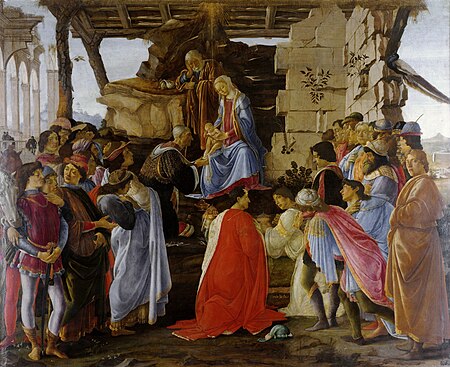
Watch this lesson to learn more about the painting.
Lorenzo married his daughter off to the son of Pope Leo VIII and bought his son Giovanni the title of Cardinal. Giovanni became Pope Leo X in 1513. Ultimately, Catherine de Medici married heir to the French Throne which made her the future queen of France and the mother of three French kings: Francis II, Charles IX and Henry III from 1559 to 1589.
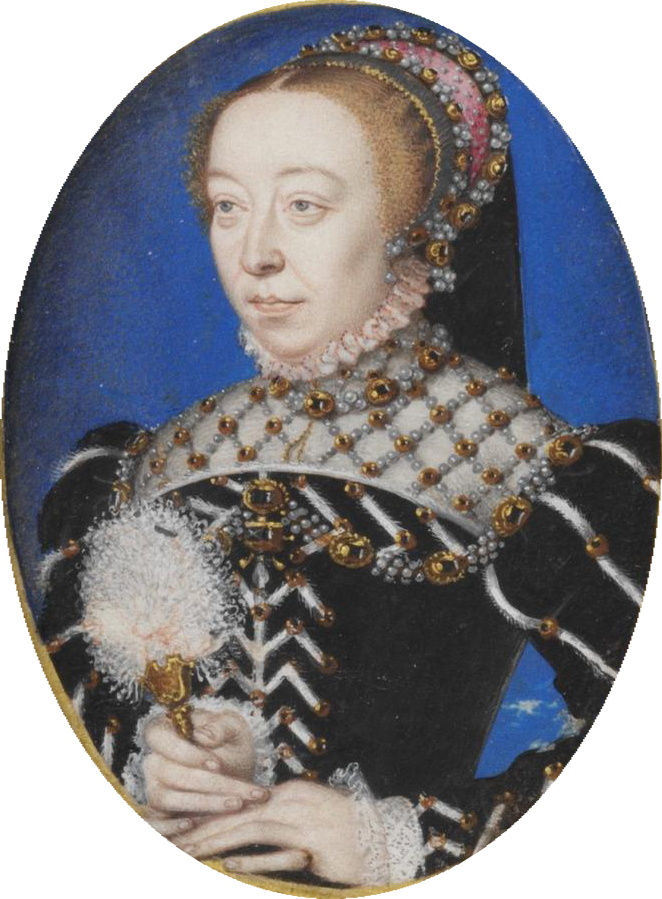
Catherine de’ Medici (above) was queen consort of France from 1547 until 1559, by marriage to King Henry II, and Queen mother of kings.
Cosimo I de Medici, the great great grandson of Lorenzo the Elder married a Spanish princess, Elenora di Toledo (pictured below).

Around 1444, Cosimo the Elder, the patriarch of the Medici family, commissioned the design of the majestic palace was entrusted to the architect Michelozzo di Bartolomeo, who completed it in about 10 years. The palace on via Larga (now via Cavour) is close to the church of San Lorenzo. This palace is the first Renaissance building erected in Florence. The chapel in the Palazzo Medici (now known as Medici-Riccardi) is an absolutely fascinating little gem; one of the most charming settings of Florence’s Renaissance. Given the chapel’s small small size, entrance to the chapel is limited to groups of up to 10 people at a time.
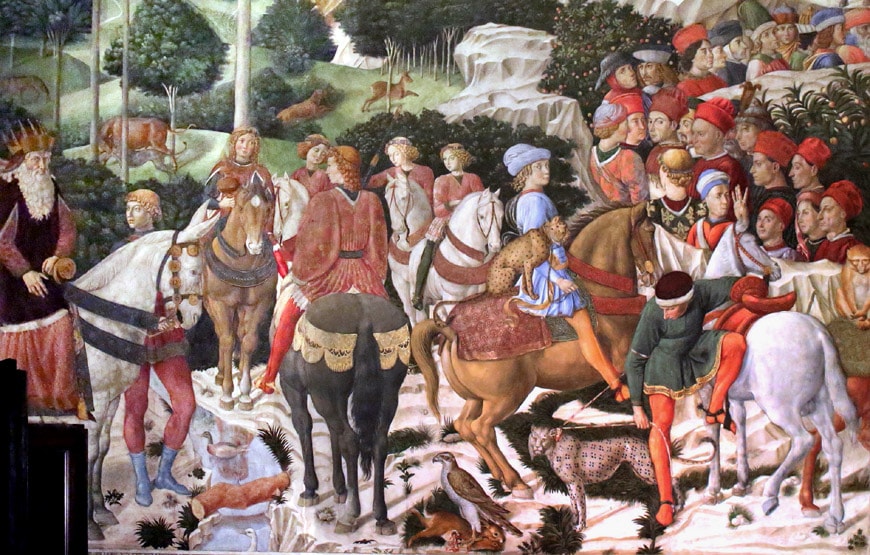
The Palazzo Medici Riccardi (located on Via Camillo Cavour, 3) is an Italian Renaissance palace and art museum in Florence. Palazzo Medici is near Santa Maria del Fiore, Eataly and The Hotel California (Via Ricasoli) where I like to stay when I visit Florence . It is also known for its Magi Chapel painted by Benozzo Gozzoli (c. 1421 – 1497) an Italian Renaissance painter from Florence. Gozzoli was trained by both Lorenzo Ghiberti and Fra Angelico and he is best known for a series of murals in the Palazzo Medici-Riccardi depicting festive, vibrant processions with wonderful attention to detail and a pronounced International Gothic influence.


The Chapel of the Magi frescoes of Benozzo Gozzoli Benozzo Gozzoli, pupil of the famous Fra Angelico, depict the Cavalcade of the Magi to Bethlehem.

Benozzo Gozzoli, Procession of the Youngest King (above), 1459-60, Palazzo Medici-Riccardi, Firenze depicts Giovanni di Cosimo de’ Medici.

East Wall, portrait of Lorenzo il Magnifico pictured above.
In the procession of knights (below), among the followers of the Magi, were numerous portraits of members of the Medici family. On the wall to the right of the altar, on horseback is Cosimo Il Vecchio, “the Elder”, who commissioned the work as well as his son Piero the Gouty and his grandchildren Lorenzo and Giuliano. The young man on horseback leading the procession is Lorenzo, who later will be known as ” the Magnificent“.
The fresco also includes collaborators and allies of the family (bankers as well as political supporters) according to the custom of the time, such as Sigismondo Malatesta, Lord of Rimini and Galeazzo Sforza, Duke of Milan.

The Palazzo Medici Riccardi was the main residence of the House of Medici before they moved into the Palazzo Pitti in the 17th century. The design of the majestic palace was entrusted to the architect Michelozzo di Bartolomeo, who completed it in about 10 years. The stone palace was completed in 1484 with architectural elements of rustication and ashlar. It is characterized by a huge cornice crowning the roof line, the palace has arched windows arranged along its front and a partially closed loggia on the corner of the building. Two asymmetrical doors led to the typical 15th century courtyard that originally opened on to a Renaissance garden. In 1517, the original building was altered by closing the loggia and adding the two “kneeling” windows according to Michelangelo’s project. Originally designed as a sort of cube with ten windows for each ground and three big doors in the facade.

The family of Piero de’ Medici portrayed by Sandro Botticelli in the Madonna del Magnificat pictured above.
In the Medici family tree, there were countless Cardinals, two Popes, two Queens of France, and seven Grand Dukes of Tuscany. The Medici produced three Popes: Pope Leo X (1513–1521), Pope Clement VII (1523–1534), and Pope Leo XI (1605). There were also two queens regent of France—Catherine de’ Medici (1547–1559) and Marie de’ Medici (1600–1610).

In 1532, the family acquired the hereditary title Duke of Florence. In 1569, the duchy was elevated to the Grand Duchy of Tuscany after territorial expansion. The Medici Family ruled the Grand Duchy from its inception until 1737, with the death of Gian Gastone de’ Medici.


Look for Cosimo di Medici (Bronzino) at the Uffizi,
In the mid-17th century, after the Medicis relocated into the Palazzo Pitti, the old palace was sold to the Riccardi family, a wealthy dynasty of Florentine bankers who enlarged and renovated the building doubling its main facade and adding new richly decorated Baroque-style interiors.
Visit the Palatine Gallery with four centuries of remnants of the Grand Ducal Tuscan lifestyle embellished with Renaissance and Baroque paintings. I love the sumptuous chambers of the Grand Dukes with masterpieces by Raphael, Titian, Rubens, Pietro da Cortona and other painters of the Renaissance and Baroque periods.
Here’s a link to the Family Tree:
http://www.museumsinflorence.com/musei/genealogic_tree.htm

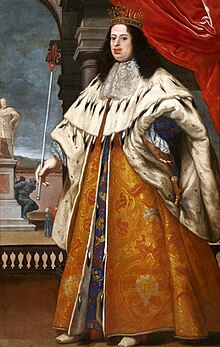
Cosimo III in Grand Ducal regalia pictured above.
Medici: Masters of Florence is an eight-part drama series Italian-British television drama chronicling the rise of the Italian Renaissance political dynasty known as the Medici family. The Medici dynasty set in 15th-century Florence, starring Dustin Hoffman as Giovanni di Bicci de’ Medici, Richard Madden as Cosimo de’ Medici, and Stuart Martin as Lorenzo de’ Medici (The Elder).
It was produced by Matilde and Luca Bernabei’s Lux Vide, and Frank Spotnitz’s Big Light Productions. Richard Madden played enterprising son Cosimo de’ Medici, while Dustin Hoffman played a pivotal role as family patriarch Giovanni de’ Medici. The story focuses on the family’s ascent from simple merchants to power brokers who sparked an economic and cultural revolution. Along the way, the family also accrues a long list of powerful enemies.
The filming spanned 18 weeks between Rome and Florence, where producers had the opportunity to shoot in historical sites such as Palazzo Vecchio, Bargello Palace, the church of San Lorenzo, and inside the Duomo. Other shoots occurred in Pienza, Montepulciano, Pistoia, Bagno Vignoni, San Quirico d’Orcia, and the UNESCO site of Val d’Orcia.

Cosimo I the Great, founder of the Grand Duchy of Tuscany is pictured above.
The series is set in the 15th-century Florence, and the protagonist is Cosimo the Elder, who was elected head of the Florentine Republic in 1434. Cosimo has inherited the Bank of Medici from his father Giovanni, who has been mysteriously poisoned. Through various flashbacks (20 years prior), we are introduced to Florence at the time of Giovanni, and to his relationship with his sons Cosimo and Lorenzo.

From left to right: The Grand Duchess Maria Maddalena, The Grand Duke Cosimo II, and their elder son, the future Ferdinando II
The Medici are remembered as the greatest art collectors in history and helped ignite the Florentine Renaissance. Some of the amazing artists who worked for the family include: Filippo Brunelleschi, Donatello, Filippo Lippi, Botticelli, Leonardo Da Vinci, Michelangelo, Raphael, Giorgio Vasari, and Benvenuto Cellini.
After the transfer of Cosimo de’ Medici to Palazzo Vecchio in 1540 as Grand Duke, the original palace continued to be inhabited by the lesser members of the family until 1659, when Ferdinando II sold it to the Riccardi marquises.
It was at this time that the palace layout was enlarged and significantly altered. The most important works consisted in the large hall decorated with the frescoes of Luca Giordano that is one of the most significant examples of Baroque architecture in Florence, and in the new entrance staircase built by the architect Foggini. Baroque decorations were added also to the courtyard through the addition of old marbles belonging to the Riccardi collection.
The Artwork in the Chapel of the Magi
The real jewel of the building is on the first floor of the Palazzo Medici Riccardi, the Chapel of the Magi frescoed by Benozzo Gozzoli in the fifteenth century. It was the private chapel for the Medici family. In the Magi Chapel, Gozzoli adorned the frescos with a wealth of anecdotal detail and portraits of members of the Medici family and their allies, along with Byzantine emperor John VIII Palaiologos and Holy Roman Emperor Sigismund of Luxemburg parading through Tuscany in the guise of the Three Wise Men. Many of the biblical depictions allude to the Council of Florence (1438-1439), an event that brought prestige to both Florence and the Medici. Among the many faces in the frescoe, you will find Benozzo Gozzoli, whose head is turned and his eye looks out toward the observer.

Benozzo Gozzoli (pictured above as a self portrait in the fresco) was a pupil of the famous Fra Angelico He created a beautiful series of frescoes depicting the Cavalcade of the Magi to Bethlehem. The procession of the Magi frescoes explicitly referred to the train of the Concilium that met in Florence in 1439. Many of the personalities portrayed are wealthy residents of Florence and of the time and members of the Medici family. Benozzo Gozzoli painted characters with sumptuous regal robes and blended art, history and public celebration.
In the procession of knights, among the followers of the Magi, on horseback is Cosimo Il Vecchio, “the Elder”, who commissioned the work as well as his son Piero the Gouty and his grandchildren Lorenzo and Giuliano. The young man on horseback leading the procession is Lorenzo, who later will be known as ” the Magnificent“.
The fresco also includes collaborators and allies of the family (bankers as well as political supporters) according to the custom of the time, such as Sigismondo Malatesta, Lord of Rimini and Galeazzo Sforza, Duke of Milan.

The fresco’s colors and atmosphere bring to mind Flemish paintings and tapestries and are without a doubt the artist’s most famous work of art. The theme of the Cavalcade of the Magi occupies three of the four chapel walls, those on the eastern, southern and western sides. “The Journey of the Magi” is on the largest wall, while the “Vigil of the Shepherds awaiting the Announcement” is on the wall above the doors to the sacristies.
In the chapel you can find Filippo Lippi‘s Adoration in the Forest as the altarpiece. Lippi’s original is now in Berlin, while a copy by a follower of Lippi has replaced the original.
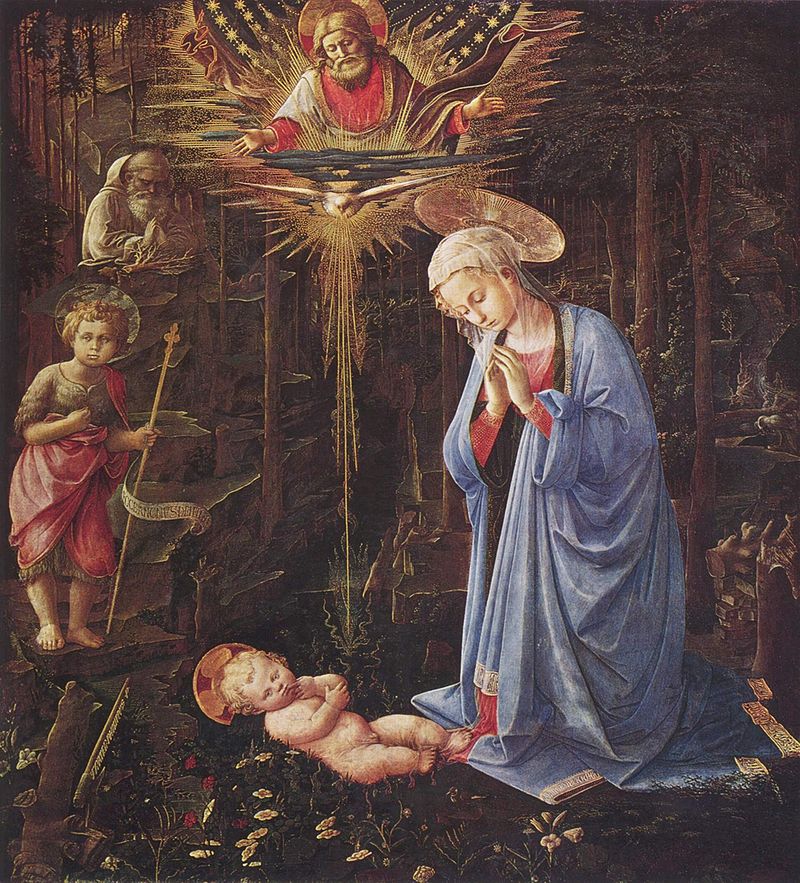
Other decorations of the palazzo included two lunettes by Filippo Lippi, depicting Seven Saints
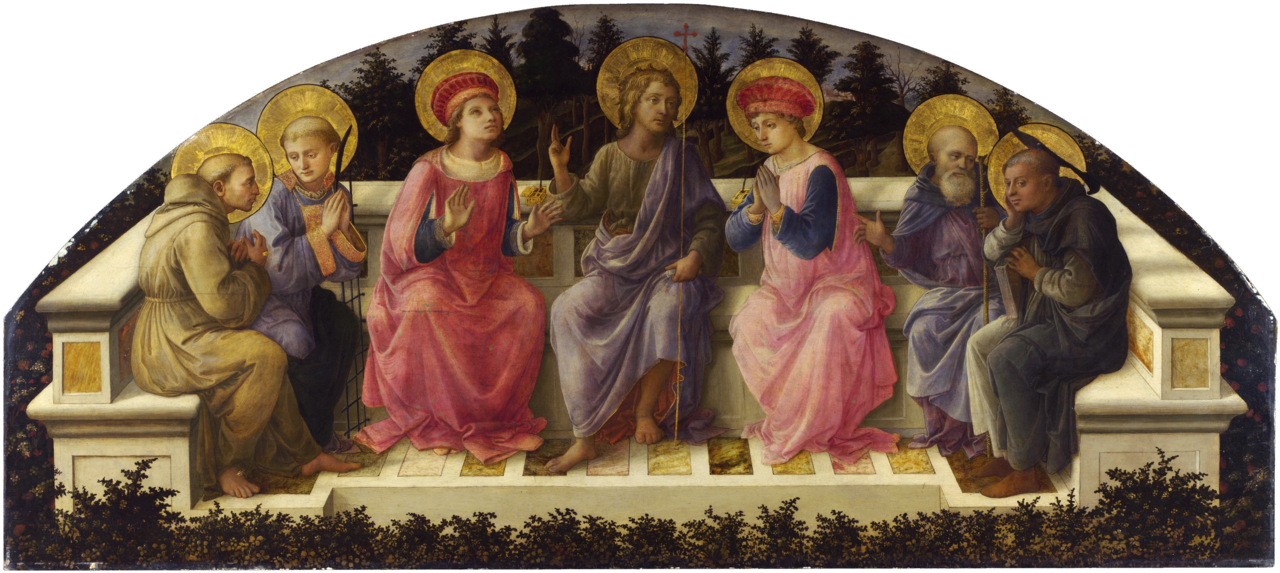
and the Annunciation shown below.
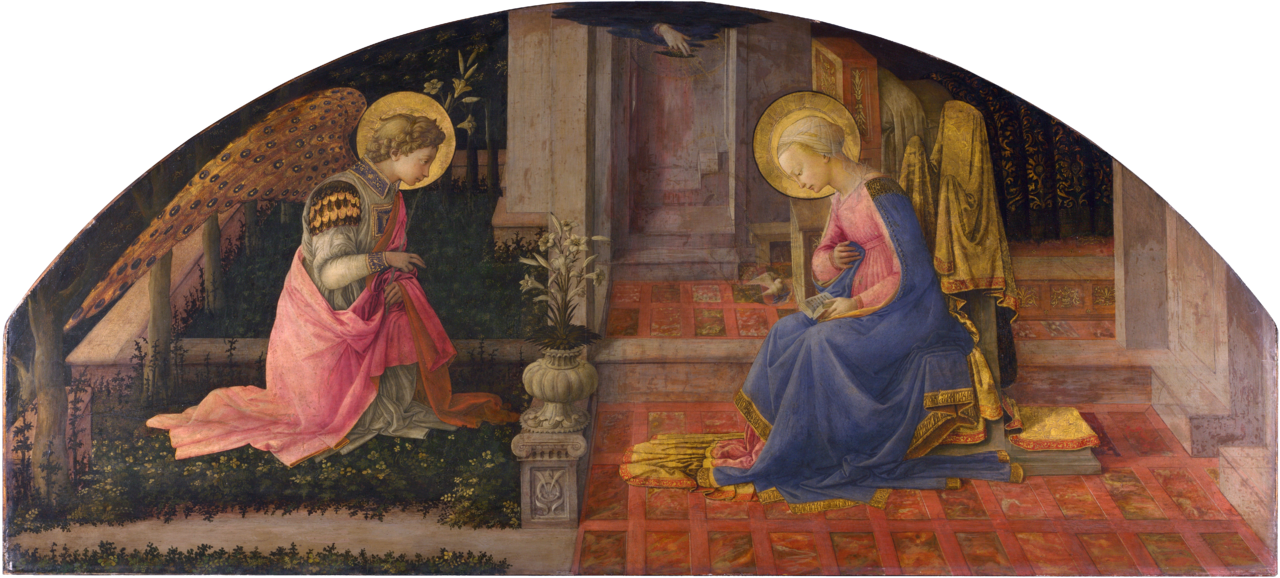 Both frescoes are at the National Gallery, London.
Both frescoes are at the National Gallery, London.
The building is one of the first examples of what later became known as Renaissance architecture in Florence, even though it still has many traditional elements such as the use of “pietra forte”, the lower “rustic” hewn stones and mullioned windows.
The tripartite elevation used here expresses the Renaissance spirit of rationality, order, and classicism on human scale. This tripartite division is emphasized by horizontal string courses that divide the building into stories of decreasing height. The transition from the rusticated masonry of the ground floor to the more delicately refined stonework of the third floor makes the building seem lighter and taller as the eye moves upward to the massive cornice that caps and clearly defines the building’s outline.

Michelozzo was influenced in his design of the palace by both classical Roman and Brunelleschian principles. During the Renaissance revival of classical culture, ancient Roman elements were often replicated in architecture. In the Palazzo Medici Riccardi, the rusticated masonry and the cornice had precedents in Roman practice, yet in totality it looks distinctly Florentine, unlike any known Roman building.

VIsit the Medici Chapels



The Medici Chapels are two beautiful chapels in the historic Basilica of San Lorenzo, which set the stage for the Renaissance. They’re a great stop if you’re short on time, a Michelangelo buff, or want to feel like a Medici prince or princess—even for an hour. To truly understand the history of the Medici family and Michelangelo this is a must see treasure in Florence. Tickets, which cost €9 (about $10) and can be booked online or in person.
Trivia
- When the Medici family returned to Florence after their short exile in the early 15th century, they kept a low profile and exercised their power behind the scenes. This is reflected in the plain exterior of this building, and is said to be the reason why Cosimo de’ Medici rejected Brunelleschi’s earlier proposal.
- The palace was the site of the wedding reception between Ferdinando de’ Medici, Grand Prince of Tuscany and Violante Beatrice of Bavaria in 1689.
- In 1938 a dinner between heads of state Benito Mussolini and Adolf Hitler was held in the palace.
Planning your Visit
http://www.museumsinflorence.com/musei/medici_riccardi_palace.html
Address: Via Cavour, 3
Florence
Tickets: Full price: € 7,00
Reduced price: € 4,00
Opening times: From Monday to Sunday, 9am to 6pm
Ticket office closes at 5pm
Closed on Wednesdays
Visits: Entrance to the chapel is reserved to a maximum of 10 visitors every 7 minutes
You can make reservations by phone at 055 2760340 or just wait in line
The Palace hosts temporary exhibitions, included in the entrance ticket to the museum and the Chapel of the Magi.


The main and most famous part of the chapel is the scene of the “Journey of the Magi”
Visit these amazing structures in Florence:










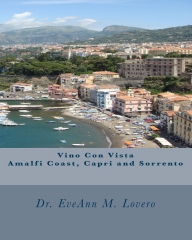
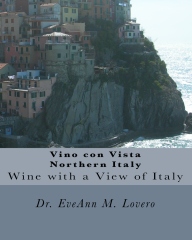
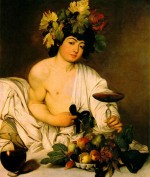

Good to read the post 🙂
I’m glad that you enjoyed it!